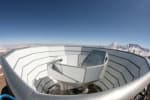At the South Pole, there exists the IceCube Neutrino Observatory, a gigaton-scale detector that detects tiny, nearly massless particles called neutrinos. Neutrinos can travel unhindered through space and, thus, can help uncover otherwise obscured parts of the universe. Many IceCube analyses study a diffuse neutrino flux—coming from all directions across the entire sky—that originate mostly […]
Research
A search for a correlation between millimeter-bright blazars and astrophysical neutrinos
Blazars are active galactic nuclei (AGN)—supermassive black holes at the centers of galaxies—that shoot out powerful jets of particles and light directed at Earth, making them some of the brightest objects in the universe. Because blazars can accelerate particles to extremely high energies, they are an attractive candidate as sources for high-energy neutrinos, the subject […]
IceCube’s first hunt for neutrino sources using two types of signals
The origins of cosmic rays—and the astrophysical sources responsible for producing and accelerating them—remain an open question in science. However, high-energy neutrinos, nearly massless subatomic particles, may hold the key to resolving this long-standing mystery. At the South Pole, the IceCube Neutrino Observatory occupies a cubic kilometer of ice in search of high-energy neutrinos from […]
IceCube reaches 20-year milestone in quest to uncover the makeup of ultra-high-energy cosmic rays
Cosmic rays are charged particles that rain down on Earth from space, with energies that can reach as high as a fast-thrown baseball packed into a single subatomic particle. Although a lot is known about cosmic rays, their origin still remains a century-old mystery. The highest energy particles, called ultra-high-energy cosmic rays (UHECRs), are closely […]
Improved IceTop measurements add to the cosmic-ray muon puzzle
When charged particles from outer space called cosmic rays collide with particles in the Earth’s atmosphere, they create a shower of secondary particles (air showers) that cascade down to Earth. These secondary particles include photons, electrons, and muons. Some of these secondary particles reach the IceCube Neutrino Observatory at the South Pole, a detector consisting […]
Reconstruction of low-energy neutrinos using convolutional neural networks
When cosmic rays crash into the Earth’s atmosphere, air showers containing atmospheric muons and neutrinos are produced. The atmospheric neutrinos are then detected by DeepCore, a denser array of sensors in the bottom center of the IceCube detector at the South Pole. Compared to the main IceCube detector, DeepCore is sensitive to neutrinos down to […]
Probing the high-energy region using muon neutrinos from the southern sky
Neutrinos are weakly interacting particles that are able to travel unhindered through the cosmos. The IceCube Neutrino Observatory, embedded in a cubic kilometer of Antarctic ice, searches for neutrinos and captures them at different energies. By measuring the entire spectrum of astrophysical neutrinos, scientists can gain insights into the origin and acceleration mechanisms of highly […]
Extended IceCube study on seasonal variations of the atmospheric neutrino spectrum
Over the years, the IceCube Neutrino Observatory at the South Pole has collected an abundant amount of muons and neutrinos produced in the Earth’s atmosphere. These neutrinos are produced when high-energy particles called cosmic rays collide with atoms in the Earth’s atmosphere and produce “air showers” that rain down on Earth. Previous studies showed that […]
Measurement of the neutrino inelasticity using IceCube DeepCore
When a muon neutrino crashes into the ice, it sometimes produces a hadronic shower and a muon, which are then detected by one of the 5,000 sensors of the IceCube Neutrino Observatory. This hadronic shower carries a fraction of the energy of the original neutrino. This fraction is described by a parameter known as inelasticity. […]
Search for neutrino multiplets from transient sources
Ever since high-energy astrophysical neutrinos were first observed in 2013, the IceCube Neutrino Observatory at the South Pole has continued searching for their elusive sources. Thus far, evidence of high-energy neutrino emission has been found from the blazar TXS 0506+056, the active galaxy NGC 1068, and most recently, the Milky Way. Still, neutrino emission from […]









